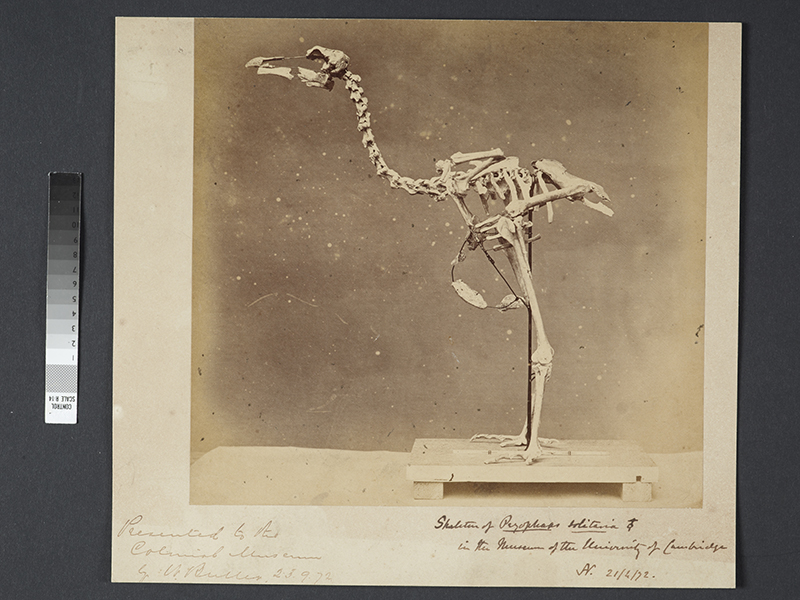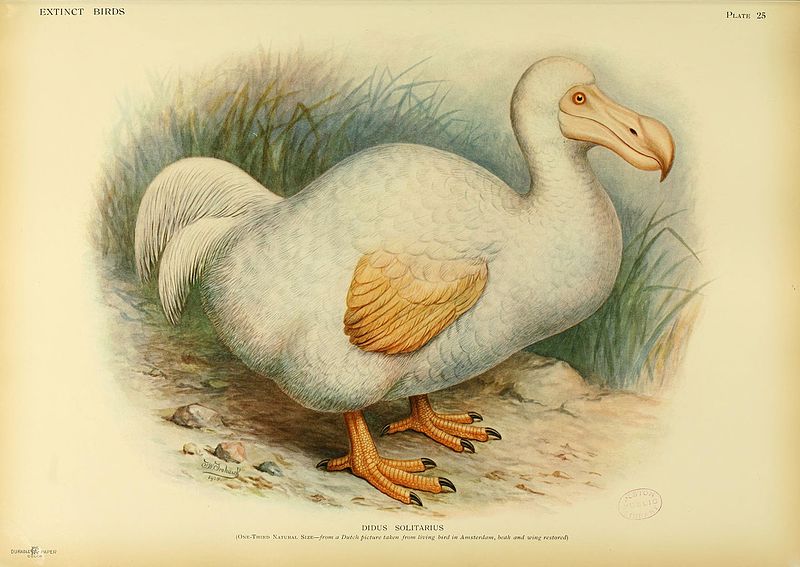Pezophaps solitaria (Gmelin, 1789:728)
Rodrigues solitaire, Rodrigues solitary
Taxonomy & Nomenclature
See Young et al. (2024) for a complete synonymy, as well as technical discussion of relevant taxonomic issues.
Conservation Status
Extinct (WCMC, 1992:211; BirdLife International, 2016)
Last record: 1761 (BirdLife International, 2016); 1765 (WCMC, 1992:211; Kittelberger et al., 2024)
IUCN RedList status: Extinct
Distribution
Rodrigues (=Rodriguez), Mascarene Islands
Biology & Ecology
Hypodigm
Museum of New Zealand Te Papa Tongarewa:
Media

Above: Skeleton of Pezophaps solitaria, circa 1870, United Kingdom, maker unknown. Te Papa (O.031153)

Above: the solitaire mistakenly treated as a white dodo. plate 25 from Rothschild (1907). Source: Wikimedia Commons.
References
Original scientific description:
Gmelin, J. F. (1789). Caroli a Linné, Systema Naturae. Lipsiae: Georg Emanuel Beer.
Other references:
Allen, Barbara. (Due May 2025). Lost Animals, Disappearing Worlds: Stories of Extinction. Reaktion Books. 248 pp, 38 figs.
Armstrong, E. A. (1953). Territory and birds. A concept which originated from study of an extinct species. Discovery 1953(July): 223-224.
Atkinson, G. (1922). The extraordinary voyage in French literature. Vol. 2. From 1700 to 1720. Paris: Champion.
Barentine, John C. (2016?). Turdus Solitarius/Noctua. The Lost Constellations, Part of the series Springer Praxis Books pp 449-464 [Abstract]
Bartlett, A. D. (1851). On some bones of Didus. Proc Zool Soc Lond. 19: 280-284.
BirdLife International. (2012). Pezophaps solitaria. In: IUCN 2012. IUCN Red List of Threatened Species. Version 2012.2. (http://www.iucnredlist.org). Downloaded on 17 March 2013.
BirdLife International. (2016). Pezophaps solitaria. The IUCN Red List of Threatened Species 2016: e.T22690062A93259685. https://dx.doi.org/10.2305/IUCN.UK.2016-3.RLTS.T22690062A93259685.en. Accessed on 02 July 2022.
Brooks, T. 2000. Extinct species. In: BirdLife International (ed.), Threatened Birds of the World, pp. 701-708. Lynx Edicions and BirdLife International, Barcelona and Cambridge, U.K.
Byrkjedal, Ingvar, Grønstøl, Gaute and Lislevand, Terje. (2016). Possible resource-defence polygyny in the extinct Rodrigues Solitaire Pezophaps solitaria (Columbidae: Raphini). Ibis 158(1): 199-201.
Cheke, A.S. 1987. An ecological history of the Mascarene Islands, with particular reference to extinctions and introductions of land vertebrates. In: Diamond, A.W. (ed.), Studies of Mascarene island birds, pp. 5-89. Cambridge University Press, Cambridge, U.K.
Cheke, Anthony S. (2013). Extinct birds of the Mascarenes and Seychelles - a review of the causes of extinction in the light of an important new publication on extinct birds. Phelsuma 21: 4-19.
Cheke, A.S. & Hume, J.P. 2008. Lost Land of the Dodo: The Ecological History of Mauritius, Réunion and Rodrigues. London: A&C Black & New Haven, CT: Yale University Press.
Cowles, G. S. 1987. The fossil record. In: Diamond, A.W. (ed.), Studies of Mascarene Island birds, pp. 90-100. Cambridge University Press, Cambridge, U.K.
Fuller, Errol. (1988). Extinct Birds. New York: Facts on File Publications. 256 pp.
Fuller, Errol. (2002). Dodo: A Brief History. New York: Universe Publishing. 180 pp.
Genne de la Chancelière. (1735). Observations sur les îles de Rodrigue et de France en mars [ed. A. Lougnon]. Receuil trimestriel de documents et travaux inédits pour servir à l'histoire des Mascareignes françaises 1: 210-238 (1933).
Grihault, Alan. (2007). Solitaire: the Dodo of Rodrigues Island. Mauritius: Self published. 117 pp.
Hachisuka, M. (1937). Revisional note on the didine birds of Réunion. Proc. Biol. Soc. Washington 50: 69-71.
Hachisuka, M. (1953). The Dodo and kindred birds. Witherby, London.
Halliday, Tim. (1978). Vanishing Birds: Their Natural History and Conservation. London: Sidgwick & Jackson.
del Hoyo, J., Collar, N.J., Christie, D.A., Elliott, A. and Fishpool, L.D.C. 2014. HBW and BirdLife International Illustrated Checklist of the Birds of the World. Volume 1: Non-passerines. Lynx Edicions BirdLife International, Barcelona, Spain and Cambridge, UK.
Hume, Julian Pender. (2005). Contrasting taphofacies in ocean island settings: the fossi! record of Mascarene vertebrates. In ALCOVER, J .A. & BOVER, P. (eds.): Proceedings of the International Symposium "Insular Vertebrate Evolution: the Palaeontological Approach': Monografies de la Societat d'Història Natural de les Balears 12: 129-144.
Hume, Julian Pender. (2013). A synopsis of the pre-human avifauna of the Mascarene Islands, pp. 195-237. In: Göhlich UB, Kroh A, editors. Proceed. 8th Internat. Meeting Society ofAvian Paleontology and Evolution. Wien, Naturhistorisches Museum.
Hume, Julian Pender and Steel, Lorna. (2013). Fight club: a unique weapon in the wing of the solitaire, Pezophaps solitaria (Aves: Columbidae), an extinct flightless bird from Rodrigues, Mascarene Islands. Biological Journal of the Linnean Society 110(1): 32-44.
Hume, Julian Pender et al. (2014). In the footsteps of the bone collectors: nineteenth-century cave exploration on Rodrigues Island, Indian Ocean. Historical Biology DOI:10.1080/08912963.2014.886203
Hume, Julian Pender and Walters, Michael. (2012). Extinct Birds. London: T & AD Poyser.
Janoo, Anwar. (2000). Rooting the Dodo Raphus cucullatus Linnaeus 1758 and the Solitaire Pezophaps solitaria Gmelin 1789 within the Omithurae: a cladistic reappraisal. Ostrich 71(1-2): 323-329. [Abstract]
Kittelberger, Kyle D., Tanner, Colby J., Buxton, Amy N., Prewett, Amira and Şekercioğlu, Çağan Hakkı. (2024). Correlates of avian extinction timing around the world since 1500 CE. Avian Research 15: 100213. https://doi.org/10.1016/j.avrs.2024.100213 [Supplementary data (List of 216 taxa)]
Knox, Alan G. and Walters, Michael P. (1994). Extinct and endangered birds in the collections of The Natural History Museum. British Ornithologists' Club Occasional Publications 1: 1-292. [p. 134]
Le Monnier, Pierre-Charles. (1776). Constellation du Solitaire. Mémoires de l’Académie Royale des Sciences.
Leguat, F. (1708). Voyage et aventures de Francois Leguat et des ses compagnons en deux isles desertes des Indes Orientales. 180 pp. London (David Mortier, Marchand Làbraire).
Livezey, Bradley C. (1993). An ecomorphological review of the dodo (Raphus cucullatus) and solitaire (Pezophaps solitaria), flightless Columbiformes of the Mascarene Islands. Journal of Zoology, London 240: 247-292. [vol. 230?]
Mortensen, T. (1933). On the "Solitaire" of the Island of Rodriguez. Ardea 22: 21-29.
Newton, A. (1865). On a remarkable discovery of didine bones in Rodriguez. Proceedings of the Zoological Society of London [1865]: 715-718.
Newton, E. and Clark, J. W. (1879). On the osteology of the solitaire (Pezophaps solitaria. Gmel.). Philosophical Transactions of the Royal Society 168 (extra volume): 438-451.
Newton, A. & Newton, E. 1868. On the osteology of the Solitaire or didine bird of the island of Rodriguez, Pezophaps solitaria (Gmel.). Proc. R. Soc. Lond. 16: 428–433.
Newton, Alfred and Newton, Edward. (1869). On the Osteology of the Solitaire or Didine Bird of the Island of Rodriguez, Pezophaps solitaria (Gmel). Philosophical Transactions of The Royal Society of London 159: 327-362.
North-Coombes, A. (1991). The vindication of François Leguat. 2nd edition, revised. Rose-Hill, Mauritius: Éditions de 'Océan Indien.
Ottow, B. (1950). Die erbbedingte Osteogenesis dysplasticoexostotica der ausgerotteten flugunfähigen Riesentaube Pezophaps solitaria der Mascareneninsel Rodriguez. Kungliga Svenska Vetenskapsakademiens Handlingar 9: 1-37.
Ottow, B. (1951). Eine Erbkrankheit an dem Knochensystem der ausgerotteten Riesentaube Pezophaps der Maskareneninseln. Die Naturwissenschaften 38: 197-200.
Ottow, B. (1952). Ergänzende untersuchungen über die erbbedingte Osteogenesis dysplastico-exostotica bei Pezophaps solitaria. Anatomischer Anzeiger 99: 193-200.
Owen, Richard. (1872). Miscellaneous (Osteology of the Solitaire). Ann. Mag. Nat. Hist. 4(9): 241-242.
Owen, Richard. (1878). On the solitaire (Didus solitarius, Gm; Pezophaps solitaria Strkl.). Ann. Mag. Nat. Hist. 5(1): 87-98.
Parish, Jolyon C. (2012). Bibliography of the Didinæ, in The Dodologist’s Miscellany. Available at: http://sites.google.com/site/dodologistsmiscellany/ [accessed 9 February 2017]
Parish, Jolyon C. (2013). The Dodo and the Solitaire: a natural history. Indianapolis: Indiana University Press, 406 pp.
Parish, Jolyon C. (2025). The phylogenetic relationships of the Dodo (Raphus cucullatus) and the Solitaire (Pezophaps solitaria) within Columbidae (Aves: Columbiformes), including other large extinct taxa, based on morphological data. Historical Biology. https://doi.org/10.1080/08912963.2025.2473546
Pingré, [A-] G. (1763). Voyage à l'isle Rodrigue. MS 1804, Bibliothèque Ste. Geneviève, Paris [edited & re-arranged version of his diary, MS 1803 (1760-62). Republished 2004. Paris: Le Publieur].
Rijsdijk, Kenneth F., Croll, Jasper C. et al. (2024). Sea level rise and the evolution of aggression on islands. iScience 27: 111236. https://doi.org/10.1016/j.isci.2024.111236
Rodríguez-Pontes, Martín A. (2014). Digital reconstruction of Rodrigues Solitaire (Pezophaps solitaria) (Aves: Columbidae) physical appearance based on early descriptive observation and other evidence. Historical Biology: An International Journal of Paleobiology DOI:10.1080/08912963.2014.954569 [Abstract]
Rothschild, Lionel Walter. (1907). Extinct birds: an attempt to write in one volume a short account of those birds which have become extinct in historical times, that is within the last six or seven hundred years: to which are added a few which still exist, but are on the verge of extinction. London: Hutchinson & Co. XXIX + 243 pp. [p. 177-179, pl. 23, 25B]
Sayol, Ferran, Steinbauer, Manuel J., Blackburn, Tim M., Antonelli, Alexandre and Faurby, Søren. (2020). Anthropogenic extinctions conceal widespread evolution of flightlessness in birds. Science Advances 6(49): eabb6095. https://doi.org/10.1126/sciadv.abb6095 [Supplementary Material (Data File S1)]
Shapiro, Beth et al. (2002). Flight of the Dodo. Science 295(5560): 1683.
Slater, H. H. (1879). Observations on the bone caves of Rodrigues. Philosophical Transactions of the Royal Society of London 168: 420-422.
Soares, André E. R. et al. (2016). Complete mitochondrial genomes of living and extinct pigeons revise the timing of the columbiform radiation. BMC Evolutionary Biology 16: 230.
Storer, R. W. (1970). Independent evolution of the Dodo and the Solitaire. Auk 87: 396-370.
Strickland, Hugh Edwin. (1853). On some bones of birds allied to the Dodo, in the collection of the Zoological Society of London. Trans Zool SocLond. 4: 187-196.
Strickland, Hugh Edwin and Melville, Alexander Gordon. (1848). The dodo and its kindred: Or the history, affinities, and osteology of the dodo, solitaire, and other extinct birds of the islands Mauritius, Rodriguez and Bourbon. London (UK): Reeve, Benham & Reeve. viii, 141 pp. [WARNING: 14 MB file]
Tyrberg, Tommy. (2009). Holocene avian extinctions, pp. 63-106. In: Turvey, Samuel T. (ed.). Holocene Extinctions. Oxford, UK & New York, USA: Oxford University Press. xii + 352 pp.
Vargas, Pablo. (2023). Exploring ‘endangered living fossils’ (ELFs) among monotypic genera of plants and animals of the world. Frontiers in Ecology and Evolution 11: 1100503. https://doi.org/10.3389/fevo.2023.1100503
WCMC (World Conservation Monitoring Centre). (1992). Global Biodiversity: Status of the Earth's living resources. London: Chapman & Hall. xx + 594 pp.
Young, Mark T., Gregory, Steven M. S. et al. (2024a). Nomenclatural addendum to ‘The systematics and nomenclature of the Dodo and the Solitaire (Aves: Columbidae), and an overview of columbid family-group nomina’. Zoological Journal of the Linnean Society 202(4): zlae157. https://doi.org/10.1093/zoolinnean/zlae157
Young, Mark T., Hume, Julian P., Day, Michael O., Douglas, Robert P., Simmons, Zoë M., White, Judith, Heller, Markus O. and Gostling, Neil J. (2024b). The systematics and nomenclature of the Dodo and the Solitaire (Aves: Columbidae), and an overview of columbid family-group nomina. Zoological Journal of the Linnean Society 201(4): zlae086. https://doi.org/10.1093/zoolinnean/zlae086
http://www.bbc.com/news/science-environment-42057143
